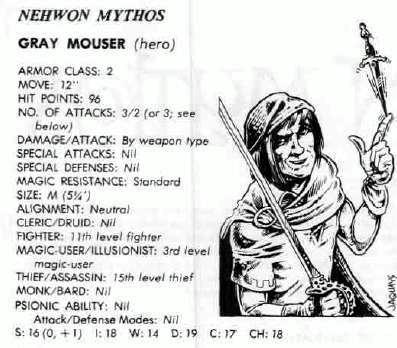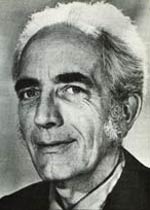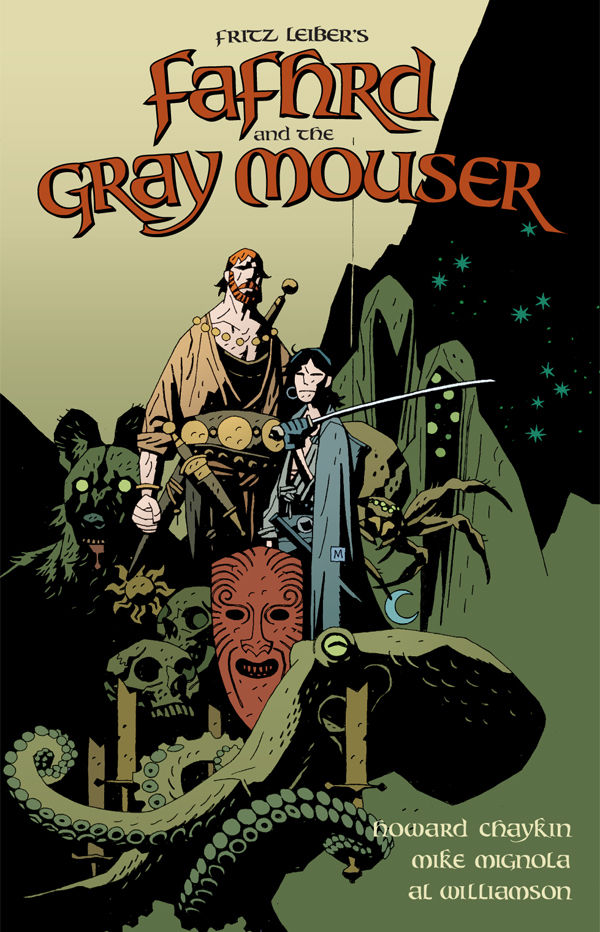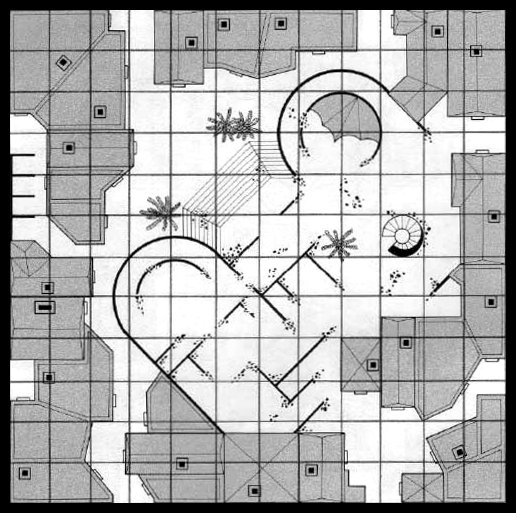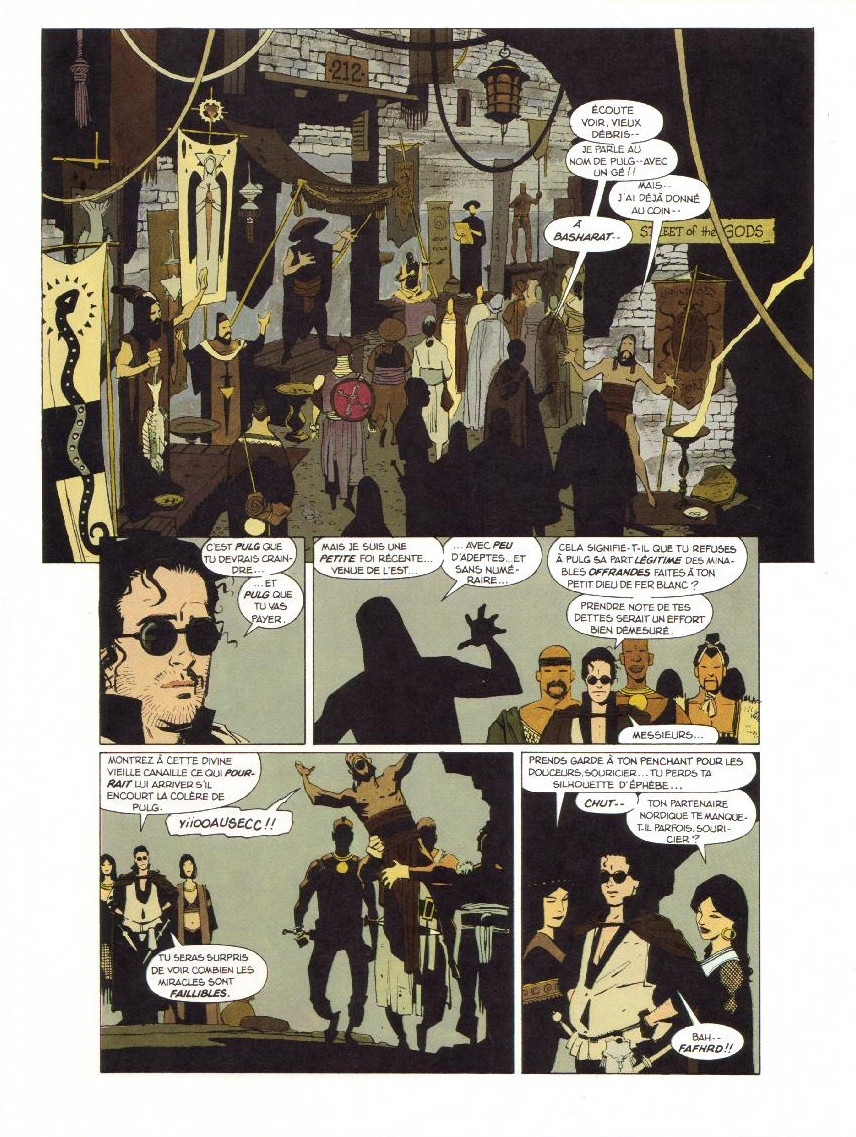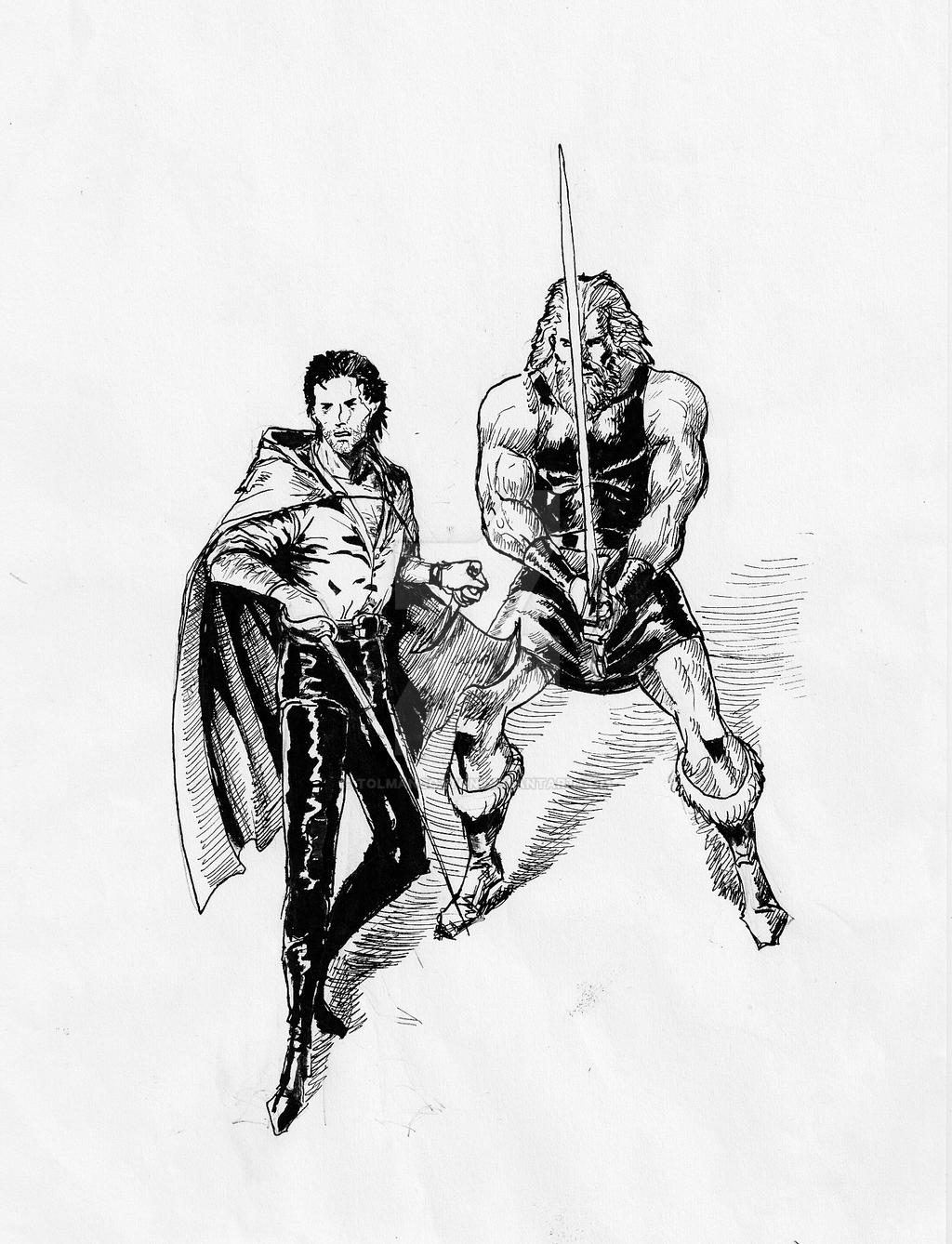These are all good ruminations, and actually have some bearing on our current chapter...
Chapter 2, AD&D (R) Game Conversions

What a lot of folks tend to forget is that D&D - in any of its many incarnations - is a generic system. This is a matter of course, because the source material they drew on wandered all over the map in terms of setting; it was none of it consistent beyond a very superficial level of wizards and dudes-with-swords-and-axes. Which, you might meditate on, covers both Conan the Cimmerian and
The Wizard of Oz. So what I'm saying is, there's a range of material to find expression for here.
That's especially hard on the simulationist aspect of early D&D - because D&D did grow out of wargaming, and the different settings, whether or not they are balanced internally in any way, sure as fuck aren't balanced against
each other. This is one of the major problems besetting a lot of generic game systems - Frank eloquently went on about GURPS in this regard in one of our OSSRs - but it's perhaps especially evident in AD&D conversions, since such a lot of the source material is only barely internally consistent. Consider, for example,
The Lord of the Rings - little plate mail, no closed helms, gunpowder and arbalests are the work of "the enemy," but no estocs or specialized pike weapons... and then consider Fafhrd & the Grey Mouser where there is no plate armor mentioned
at all, but there's a frikkin'
space station (we'll get to that later).
A large part of this is the deliberate aesthetic of the sword & sorcery and fantasy crowd. Firearms don't fit the mold of what people wanted in S&S; like the Society for Creative Anachronism, authors like Tolkien and Robert E. Howard and Fritz Leiber weren't going for historical accuracy, they're going for a pseudo-medieval period
as they wanted it to be...before World War I, before poison gas and aircraft and submarines and bombs.
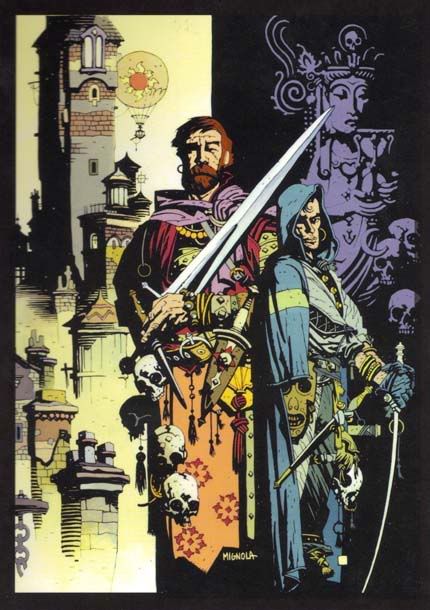
Anyway...this chapter basically sets up the AD&D 2nd edition mechanical equivalents for a lot of the basic Fafhrd & the Grey Mouser world assumptions, and sort of highlights how far apart they are in absolute terms. This isn't like Eberron where they just kitchen-sink everything: there are no orcs, no elves, no dwarfs or halflings.
Instead...ugh...for "Player Character Races" you can play different varieties of human. With their own special advantages and drawbacks. That's terrible.
Eevanmarenseers
These individuals come from a distant, decadent empire. All natives from Eevanmarensee are completely hairless, causing a -1 penalty to their charisma scores. Due to the ancient, wealthy nature of the empire, characters of this race receive 4x normal starting wealth. Eevanmarenseers may also be fire mages (see Magic Spellcasters, below).
Kleshites
This dark-complected race lives in the jungles in the south of the Lankhmar continent. They are a small, quick race, and receive a +1 to their dexterity scores. If you wish to experiment with the Earth Magic rules below, Kleshites may also be earth mages.
...also you can be Northerner, Mingol, or a Nehwon Ghouls (who are just humans with invisible flesh, but also racist against all non-transparent people, cannibals, and general assholes. More on those later.)
Class Restrictions are maybe one of the biggest red flags; Nehwon has a good bit of magic but most characters aren't running around with D&D level access to spells. So you have entries like:
Paladin: Paladins are very rare and are often considered slightly crazed. The city of Tisilinilit is known as a breeding ground for this class. paladins in Nehwon cannot use spells.
Rangers: Rangers are rare in Lankhmar, but are more common in the wilderness, especially the Cold Waste. Rangers in Nehwon-based campaigns cannot use spells. Many Cold Waste rangers also have bardic talents and may select the musical instrument proficiency at no penalty (thus occupying only one proficiency slot rather than two.
Thieves [...] Female thieves are common, but the straight-laced patriarchy of the guild will not allow female guildmembers, so all must be freelancers.
Bard: Nehwon bards function normally in all respects with the single exception that they cannot cast spells. [...]
But it's not all bad:
Clerics Clerics as a character class do not exist. See the Spellcasters section below for information on clerical magic.
Usage Note--Clerics vs. Priests: In all Nehwon and Lankhmar adventures, the term "priest" does not apply to the clerical character class. A Nehwon-based "priest" is an official representative of his or her religion and as such has only limited special powers (see 'Lankhmar's Gods" for granted powers). "Priest" is simply an occupation, and a priest may be of any character class. Note that a priest who is also a white wizard (see below) has the same abilities as a standard AD&D(R) cleric, even though he or she is not a member of that class.
I cannot stress how much I approve of this - I won't say that S&S and fantasy writers were atheistic, but as much as they populated their worlds with various gods and priests, they usually stopped short of making those folks getting special magic. In the Conan stories, a priest who casts spells is just a fucking
wizard. Tolkien was doing the guilty-Christian thing and didn't even have priests or an organized church. Fafhrd does get religion at one point - we'll get to that - but a lot of the S&S and fantasy guys usually skip the theological implications entirely, going with the implicit "look, either the gods are just fictions made up by primitive people, or they're some ancient octopus or whatever, but they don't literally empower worshippers in most cases" - the notable exception being various brands of theistic Satanism or whatever your cultural equivalent is. Christians are pretty cool with Faustian bargains. More cool with those than miracles-on-demand, really.
Speaking of which...

Fritz Leiber didn't put a vast amount of thought into his magic system. That's not to say it is completely disorganized, because he did later take a stab at it, but for narrative purposes he kept it very fluid and theatrical, with a few familiar elements - silver tending to be a good breaker of many charms, cutting the wizard's head off being another. It also isn't very
tactical; you don't see wizards just dashing off prismatic sprays like in Jack Vance novels.
So when trying to adapt Leiber's loose material to D&D mechanics...things get weird. First off, casting times and recovery times are longer; way, way longer. Anything that would take a Round to cast takes a Turn, a Turn an Hour, an Hour takes eight Hours. And after an eight-hour spell, the wizard has to go have a nap.

The big thing is that instead of normal wizards and clerics you have...White and Black Wizards.
 No, seriously, absolutely not like this, but kinda sorta
No, seriously, absolutely not like this, but kinda sorta.
Black Wizards can be neutral through level 4, but they have to shift to Evil alignment before 5th level, and they can only get higher in level with tutelage from a higher-level black wizard. Also, each level you get to roll on a d12 table to pick up a fan-fucking-tastic disfigurement or weakness.
| Die Roll |
Effect |
| 1 |
Wizard loses sight in one eye; remaining eye grows milky, white, and dead-appearing |
| 2 |
Wizard loses all hair |
| 3 |
Wizard loses all sense of taste and smell |
| 4 |
Wizard loses 1d6 points of charisma |
| 5 |
Wizard develops serious facial or body tic |
| 6 |
Wizard's face becomes misshapen and hideous |
| 7 |
Wizard's hands shrink to clublike appendages (-1d8 dexterity) |
| 8 |
Wizard's legs atrophy, causing limp and 1/2 movement rate |
| 9 |
Wizard develops irrational fear of common object or animal |
| 10 |
Wizard develops severe paranoia |
| 11 |
Wizard loses endurance, must rest for one turn after any activity |
| 12 |
Wizard develops allergy to any food not treated with rare herb |
[/td][/tr]
...for which awesome drawbacks, you get the benefit of casting as a regular D&D wizard. Albeit with longer casting times/recovery. Honestly, this shit was rife back in the day; same thing crippled Necromancers and Chaos Sorcerers in the Warhammer Fantasy Roleplaying Game.
"White wizards" have to be good, and are basically wizards who have Wisdom as their primary stat and cast Cleric and Druid spells. You also need a higher-level white wizard to tutor you each level, and can't reach higher than 5th level unless Wisdom is your highest attribute (which can lead to the weird position where you read a magical
manual, buff up, and then have to bulk down so that you can level up, but I digress).
Leiber doesn't usually draw the lines that explicitly when it comes to white magicians vs. black magicians, although it's not an uncommon Manichaean ideal, and magic in general tends to be necromancy and sorcery and things man-was-best-not-to-study kinda stuff. Then again, Fafhrd and the Grey Mouser both deal with a pair of powerful magic-users on a regular basis, and those guys don't fall into either category...or any easy categorization.
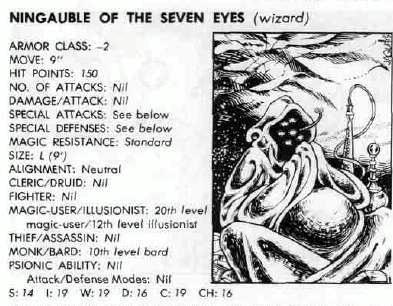
A third variety also crops up here: Elementalists. This is not
entirely a pitch to sell gamers on the
Tome of Magic (AD&D 2nd edition), although that must have been a plus, since Leiber does explicitly mention elemental magic. He just doesn't go into great detail about it - at least, certainly not as much detail as this.
 Six books in and we haven't upgraded our weapons yet.
Six books in and we haven't upgraded our weapons yet.
Evil elementalist still have to roll for disfigurement, but can otherwise be of any alignment and have both Wisdom and Intelligence 15 or higher. There are some weird requirements as far as where they can apply their magic (it's supposed to only be when you're surrounded by the element, with air magic only possible if you're suspended in midair or some shit), and elementalists are supposed to become more...whatever as they grow in level. Aquatic for water mages, stocky and slow for earth mages, etc. There's no system for this. They also throw in Ice Magic and Wild Magic for shits and giggles.
The chapter ends with some notes on dual-classing ("Multi-talented individuals are well-known in Lankhmar. Both Fafhrd and the Mouser are dual-classed [...]") and then some tables for rolling followers if your fighter hits 9th level.
Next up:
Chapter 3 - The City of Lankhmar